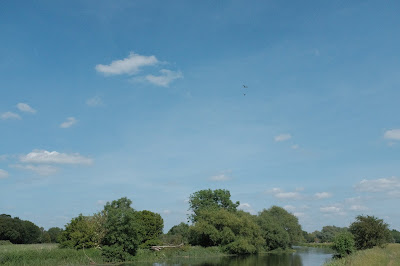To clear our minds of selfish care
 |
| A bird of prey in a “dogfight” over the River Great Ouse, Houghton |
A short “thought for the day” offered to the Cambridge Unitarian Church as part of the Sunday Service of Mindful Meditation
(Click on this link to hear a recorded version of the following piece)
—o0o—
There is much talk in our modern culture about how the “natural world” . . . which is already a deeply problematic term because our so-called “human world” is as much part of the natural world as anything else . . . Anyway, there is much talk about how the “natural world” functions as a kind of “‘natural’ sanatorium for a convalescent” (Erazim Kohák: “The Embers and the Stars”, University of Chicago Press, 1987, p. 43). Consequently, many people speak about the “healing power of nature” believing that simply by leaving the town and our countless human artefacts and going for a good long walk in the countryside, or by staying in some rural spot for a few days or weeks beyond wifi, they will, thereby, be healed in some fashion.
But does “nature” precisely heal us? When you think about it for just a moment you realise that this is not true, or at least it is not true in the superficial way we might like to think it is. The truth is nature naturing is always killing us; after all, to live is to die. COVID-19 is nature naturing and that virus is currently killing over 100 people a day in the UK alone. We may say the same for cancer, flu, volcanoes, floods, and earthquakes. No, nature does not obviously heal us.
But, for all that, we are all acutely aware that something astonishing does happen when we take that walk in the countryside and find ourselves standing awestruck in the presence of, and fully immersed within, the beauty and power of nature naturing whether in the form of a breathtaking view, a flower of the field, a bird of the air, a sunset or the starry night above us. So what is happening in these moments?
Well, the philosopher, Erazim Kohák (1933–2020), suggests that nature naturing doesn’t heal our pain and woes but, instead, it absorbs them. Our pains and woes are not so much removed from us as we are reconciled to them as we suddenly see them as if from under the perspective of the whole (cf. “The Embers and the Stars”, University of Chicago Press, 1987, pp. 42-46).
I know of no better expression of this phenomenon than some words by the philosopher and novelist Iris Murdoch (1919-1999) found in her book “The Sovereignty of Good” (1970) (Routledge Classics, 2001, p. 82). She writes:
“Beauty is the convenient and traditional name of something which art and nature share, and which gives a fairly clear sense to the idea of quality of experience and change of consciousness. I am looking out of my window in an anxious and resentful state of mind, oblivious of my surroundings, brooding perhaps on some damage done to my prestige. Then suddenly I observe a hovering kestrel. In a moment everything is altered. The brooding self with its hurt vanity has disappeared. There is nothing now but kestrel. And when I return to thinking of the other matter it seems less important. And of course this is something which we may also do deliberately: give attention to nature in order to clear our minds of selfish care.”


Comments